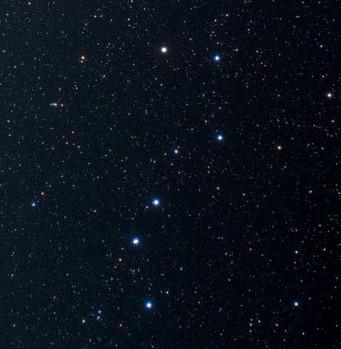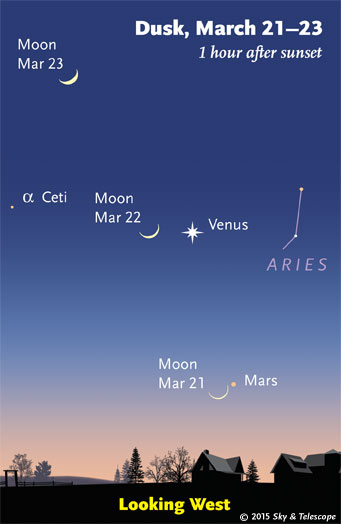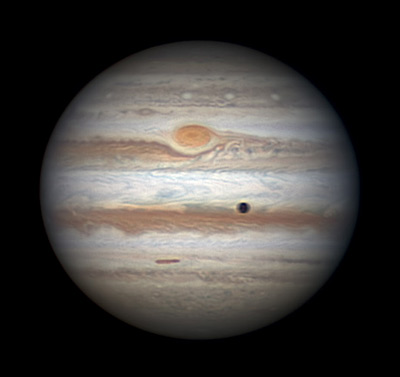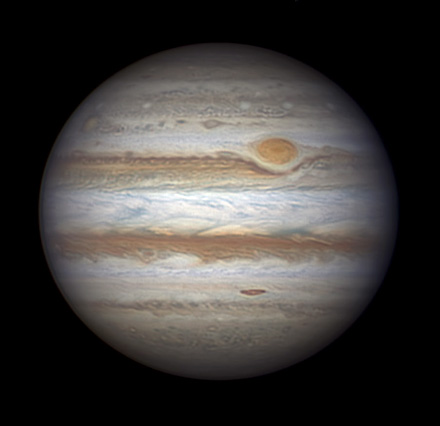Some daily sky sights among the ever-changing Moon, planets, and stars.
Friday, March 13

You know the season is shifting. As the stars come out, the Big Dipper, standing on its handle in the northeast, is now as high as Cassiopeia, which is standing on end in the northwest. The Dipper is rising into spring and summer; Cas is descending from its high showing in the fall and winter.
Last-quarter Moon (exact at 1:48 p.m. EDT). The Moon rises around 1 or 2 a.m. on the morning of Saturday the 14th. By the beginning of Saturday's dawn the Moon poses far left of Scorpius and above the upright, newly risen Sagittarius Teapot.
Saturday, March 14
On the traditional divide between the winter and spring sky is dim Cancer, marked this year by Jupiter. Wintry Gemini is to its west, and Leo of spring is to its east. Don't be too distracted by Jupiter; Cancer also hosts the Beehive Star Cluster, M44, in its middle. Look for it 6° to Jupiter's upper right after dark. That's about the width of a binocular's field of view.
Algol should be at its minimum brightness for a couple hours centered on 9 p.m. Eastern Daylight Time. Comparison-star chart.
Sunday, March 15
Have another look for Comet Lovejoy! This evening it's just a fraction of a degree from Delta Cassiopeiae, the second-dimmest star of Cassiopeia's W pattern. The comet is still 6th magnitude and fading more slowly than predicted. Nor is there bothersome moonlight in the evening sky. See Bob King's Catch Comet Lovejoy in Cassiopeia with a quickie naked-eye chart to find the right star in Cassiopeia, or Comet Lovejoy Shines On with a finder chart for every evening in March. You'll need good binoculars or a low-power telescope. Plan to go out right after dark, when Cassiopeia is still high.
Monday, March 16
The brightest point of light at dusk is Venus in the west. Second-brightest is Jupiter, much higher in the east-southeast. Look to the right of Jupiter by two or three fists at arm's length for Procyon. Look the same distance lower right of Procyon and there's the evening's third-brightest point, Sirius.
Tuesday, March 17
Jupiter this month forms a big, more-or-less equilateral triangle with Procyon and Pollux. Face southeast after dark, and Procyon is to Jupiter's lower right. Pollux is to Jupiter's upper right.
Procyon is also part of the slightly larger Winter Triangle, down to Procyon's lower right. The Winter Triangle too is equilateral. Its other stars are orange Betelgeuse in Orion and bright Sirius below.
Wednesday, March 18
The Big Dipper glitters high in the northeast these evenings, standing on its handle. You probably know that the two stars forming the front of the Dipper's bowl (currently on top) are the Pointers; they point to Polaris, currently to their left or lower left.
And, you may know that if you follow the curve of the Dipper's handle out and around by a little more than a Dipper length, you'll arc to Arcturus, which is now rising in the east-northeast.
But did you know that if you follow the Pointers backward the opposite way, you'll land in Leo?
Draw a line diagonally across the Dipper's bowl from where the handle is attached, continue far on, and you'll get to Gemini.
And look at the two stars forming the open top of the Dipper's bowl. Follow this line past the bowl's lip far across the sky, and you crash into Capella.
Thursday, March 19
Jupiter this season forms a big, temporary quadrilateral with Procyon well to its right at dusk, Regulus a little less far to Jupiter's lower left, and fainter Alphard, the orange heart of Hydra, far below Jupiter.
Friday, March 20
The Sun undergoes a total eclipse for parts of the North Atlantic and Arctic Oceans. The partial phases sweep across a much larger area: all of Europe, North Africa, and central Asia. Maps and explanations (particularly for the UK). More maps and detailed local timetables are at Fred Espenak's EclipseWise site.
As dusk turns to night, spot Venus still in the west. To its upper right by about a fist at arm's length, look for 2.0-magnitude Hamal, the brightest star of Aries. Farther to Venus's upper left or left, look for 2.5-magnitude Menkar, Alpha Ceti.
Spring begins in the Northern Hemisphere at the equinox, 6:45 p.m. EDT (3:45 p.m. PDT). This is when the Sun crosses the equator heading north for the season.
The word "equinox" comes from night and day supposedly being equal on this date, but that's just wrong. It would be true if Earth had no atmosphere and the Sun were a point rather than a disk. But with an atmosphere, daylight continues long after the moment of sunset. Second, sunrise and sunset are counted not from when the Sun's center is on the true horizon, but when its top edge is on the horizon; this adds a couple minutes to daytime. And third, atmospheric refraction at the horizon elevates the Sun by about its own apparent diameter, adding a few more minutes to official daytime.

Saturday, March 21
In twilight, look west well below Venus for a very thin waxing crescent Moon close to Mars, as shown here. The Moon is just one day old following yesterday's solar eclipse.
We see the Moon's night side (dimly Earthlit), and just a little of the sunlit side around the edge, because the Moon is nearly along our line of sight to the Sun. Faraway Mars shows us mostly its day side, because it's nearly on the same line of sight on the far side of the Sun.
Tomorrow evening the Moon will be beautifully paired with Venus; make a note to look.
________________________________
Want to become a better astronomer? Learn your way around the constellations. They're the key to locating everything fainter and deeper to hunt with binoculars or a telescope.
This is an outdoor nature hobby; for an easy-to-use constellation guide covering the whole evening sky, use the big monthly map in the center of each issue of Sky & Telescope, the essential guide to astronomy. Or download our free Getting Started in Astronomy booklet (which only has bimonthly maps).

Once you get a telescope, to put it to good use you'll need a detailed, large-scale sky atlas (set of charts). The standards are the little Pocket Sky Atlas, which shows stars to magnitude 7.6; the larger and deeper Sky Atlas 2000.0 (stars to magnitude 8.5); and once you know your way around, the even larger Uranometria 2000.0 (stars to magnitude 9.75). And read how to use sky charts with a telescope.
You'll also want a good deep-sky guidebook, such as Sue French's Deep-Sky Wonders collection (which includes its own charts), Sky Atlas 2000.0 Companion by Strong and Sinnott, the bigger Night Sky Observer's Guide by Kepple and Sanner, or the beloved if dated Burnham's Celestial Handbook.
Can a computerized telescope replace charts? Not for beginners, I don't think, and not on mounts and tripods that are less than top-quality mechanically (able to point with better than 0.2° repeatability, which means fairly heavy and expensive). As Terence Dickinson and Alan Dyer say in their Backyard Astronomer's Guide, "A full appreciation of the universe cannot come without developing the skills to find things in the sky and understanding how the sky works. This knowledge comes only by spending time under the stars with star maps in hand."
This Week's Planet Roundup


Mercury is hidden deep in the glow of sunrise.
Venus (magnitude –3.9) blazes in the west during evening twilight as the unmistakable "Evening Star."
Mars is magnitude +1.3, less than 1% as bright as Venus. It's sinking farther and farther below Venus in twilight — from 9° below it on March 13th to 12° below on the 20th.
Jupiter (magnitude –2.4, in Cancer) shines high in the southeast as the stars come out. It's the brightest point of light on that side of the sky. It passes highest in the south around 10 or 11 p.m. daylight-saving time.
It's been five weeks since Jupiter's opposition, but Jupiter is still 43 arcseconds wide in a telescope. Don't expect to see nearly the amount of detail with your eye that sophisticated video-frame stacking with a large amateur telescope can bring out, such as in the extraordinary images here!
Saturn (magnitude +0.4, at the head of Scorpius) rises around midnight or 1 a.m. daylight-saving time. It's highest in the south just as dawn begins. Below or lower left of Saturn by 8°, look for orange Antares, the Scorpion's heart.
Look just ½° below Saturn before dawn for Nu Scorpii, a showpiece double star for telescopes. And less than 2° to their right is Beta Scorpii, an even finer telescopic double.
Uranus and Neptune are lost behind the glare of the Sun.
All descriptions that relate to your horizon — including the words up, down, right, and left — are written for the world's mid-northern latitudes. Descriptions that also depend on longitude (mainly Moon positions) are for North America.
Eastern Standard Time (EST) is Universal Time (UT, UTC, or GMT) minus 5 hours. Eastern Daylight Time (EDT) is UT minus 4 hours.
“This adventure is made possible by generations of searchers strictly adhering to a simple set of rules. Test ideas by experiments and observations. Build on those ideas that pass the test. Reject the ones that fail. Follow the evidence wherever it leads, and question everything. Accept these terms, and the cosmos is yours.”
— Neil deGrasse Tyson, 2014.
 3
3
Comments
Anthony Barreiro
March 13, 2015 at 2:13 pm
I have to quibble with your quibble about "equinox." It's a medieval Latin term, going back at least to the 12th century CE. The first mechanical clocks were not invented until the 14th century. At the equinox the length of day and night are equal to within a few minutes, certainly within the margin of error of human estimation, and clearly different from the long cold nights of winter solstice or the luxuriously long days of summer solstice. The truly remarkable thing, to me, is that our ancestors were able to develop accurate solar calendars, etc., all without benefit of the mechanical and electronic tools we today take for granted.
You must be logged in to post a comment.
Tom Hoffelder
March 14, 2015 at 8:06 am
At least he didn't call it the Spring Equinox.
You must be logged in to post a comment.
bob kelly
March 18, 2015 at 10:14 pm
The atmospheric refraction also means the total solar eclipse might be visible from the North Pole..... https://www.facebook.com/WestchesterAstronomers?fref=nf even though the equinox won't have occurred yet.
You must be logged in to post a comment.
You must be logged in to post a comment.